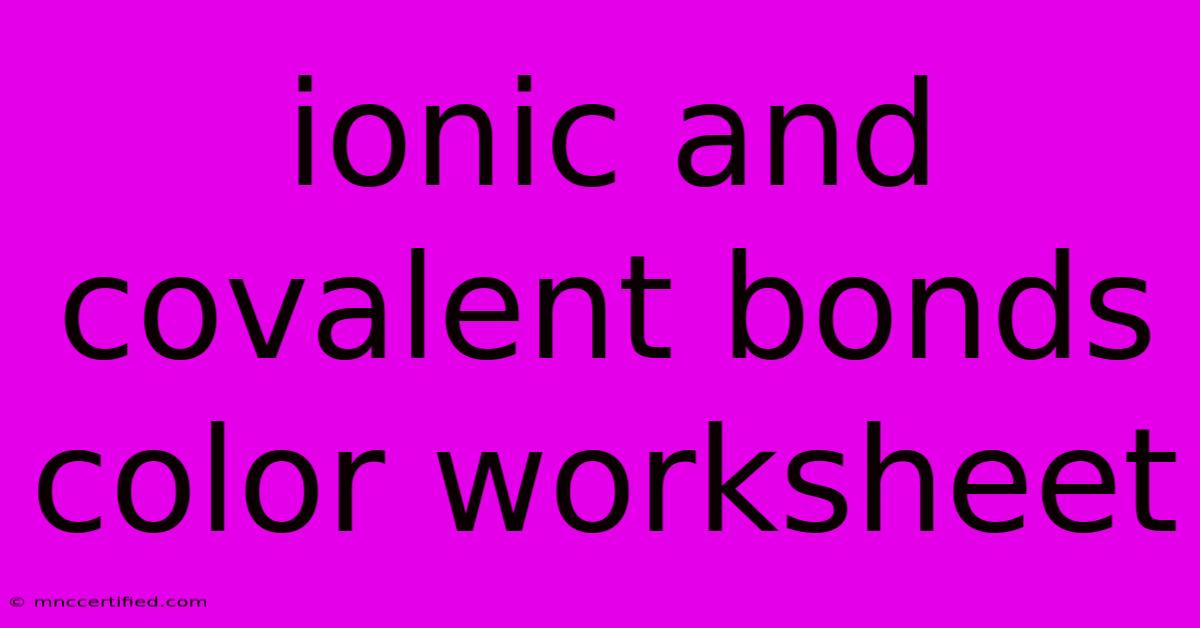Ionic And Covalent Bonds Color Worksheet

Table of Contents
Delving into the Colorful World of Ionic and Covalent Bonds: A Worksheet Adventure
Understanding the fundamental building blocks of matter is crucial for any aspiring chemist. Ionic and covalent bonds are two primary forces that hold atoms together, forming molecules and compounds. This worksheet will take you on a colorful journey to visualize and solidify your knowledge of these key concepts.
The Colorful Language of Chemical Bonding
Coloring is a powerful tool in learning chemistry. Each element has unique properties, and different colors can represent these characteristics visually. For this worksheet, we'll use a simple color-coding system:
- Metals: Represent metals using a gold color.
- Nonmetals: Represent nonmetals using a blue color.
Ionic Bonding: A Dance of Opposite Charges
Ionic bonds form when a metal atom loses electrons to become a positively charged cation, and a nonmetal atom gains electrons to become a negatively charged anion. These opposite charges attract, forming a strong electrostatic bond.
Example:
Sodium (Na), a metal, loses an electron to become a sodium ion (Na+). Chlorine (Cl), a nonmetal, gains an electron to become a chloride ion (Cl-). These ions attract each other and form the ionic compound sodium chloride (NaCl).
Worksheet Activity:
-
Color the following elements according to the key above: Sodium (Na), Chlorine (Cl), Magnesium (Mg), Oxygen (O), Potassium (K), Fluorine (F).
-
Draw the formation of the following ionic compounds:
- Sodium chloride (NaCl): Show the transfer of electrons from sodium to chlorine.
- Magnesium oxide (MgO): Show the transfer of electrons from magnesium to oxygen.
-
Write the chemical formula for each ionic compound you drew.
-
Explain why ionic bonds are strong bonds.
Covalent Bonding: Sharing is Caring
Covalent bonds form when two nonmetal atoms share electrons to achieve a stable electron configuration. This shared pair of electrons creates a strong bond between the atoms.
Example:
Two chlorine atoms each have seven electrons in their outermost shell. By sharing one electron each, they form a covalent bond, forming a chlorine molecule (Cl<sub>2</sub>).
Worksheet Activity:
-
Color the following nonmetals according to the key above: Chlorine (Cl), Oxygen (O), Carbon (C), Hydrogen (H).
-
Draw the Lewis dot structures for the following covalent molecules:
- Chlorine (Cl<sub>2</sub>): Show the shared pair of electrons.
- Water (H<sub>2</sub>O): Show the shared pairs of electrons between oxygen and hydrogen.
- Carbon dioxide (CO<sub>2</sub>): Show the shared pairs of electrons between carbon and oxygen.
-
Write the chemical formula for each covalent molecule you drew.
-
Explain why covalent bonds are strong bonds.
Beyond the Worksheet: Exploring Further
This worksheet provides a foundation for understanding ionic and covalent bonds. You can deepen your knowledge by exploring the following concepts:
- Polar and nonpolar covalent bonds: Examine the electronegativity difference between atoms and how it influences bond polarity.
- Multiple bonds: Learn about double and triple covalent bonds.
- Polyatomic ions: Investigate how multiple atoms can form ions with a charge.
By actively engaging with these concepts, you can build a strong understanding of chemical bonding and unlock the fascinating world of chemistry!

Thank you for visiting our website wich cover about Ionic And Covalent Bonds Color Worksheet. We hope the information provided has been useful to you. Feel free to contact us if you have any questions or need further assistance. See you next time and dont miss to bookmark.
Featured Posts
-
Tim Walz Back In Minnesota After Election Defeat
Nov 07, 2024
-
Volcanic Eruption In Indonesia Kills 10 Destroys Houses
Nov 07, 2024
-
Does Insurance Cover Carpal Tunnel Surgery
Nov 07, 2024
-
Fc Barcelona Headlines November 6 2024
Nov 07, 2024
-
Trump Tweets Bitcoin Price Jumps
Nov 07, 2024